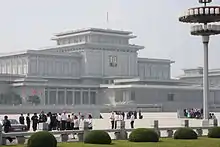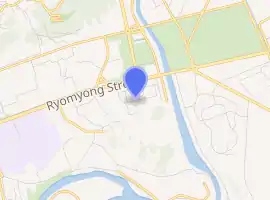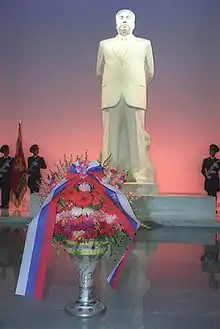Kumsusan Palace of the Sun
The Kumsusan Palace of the Sun, formerly the Kumsusan Memorial Palace, and sometimes referred to as the Kim Il-sung Mausoleum, is a building near the northeast corner of the city of Pyongyang that serves as the mausoleum for Kim Il-sung, the founder of North Korea, and for his son Kim Jong-il, both posthumously designated as eternal leaders of North Korea.[1]
| Kumsusan Palace of the Sun | |
|---|---|
 The official residence of North Korea's head of state until President Kim Il-sung's death. It has since been transformed into a mausoleum for the great leader and his son, Kim Jong-il. | |

| |
| General information | |
| Architectural style | Modern, neoclassical |
| Country | North Korea |
| Coordinates | 39°3′51″N 125°47′15″E |
| Opened | 1976 |
| Korean name | |
| Chosŏn'gŭl | |
| Hancha | |
| Revised Romanization | Geumsusan Taeyang Gungjeon |
| McCune–Reischauer | Kŭmsusan T'aeyang Kungjǒn |
The palace was built in 1976 as the Kumsusan Assembly Hall and served as Kim Il-sung's official residence. Following the elder Kim's death in 1994, Kim Jong-il had the building renovated and transformed into his father's mausoleum.[2] It is believed that the conversion cost at least $100 million.[3] Some sources put the figure as high as $900 million.[4][5] Inside the palace, Kim Il-sung's embalmed body lies inside a clear glass sarcophagus. His head rests on a Korean-style pillow and he is covered by the flag of the Workers' Party of Korea. Kim Jong-il is now on display in a room close to his father's remains and positioned in a very similar way.[6]
At 115,000 square feet (10,700 m2),[7] Kumsusan is the largest mausoleum dedicated to a Communist leader[8] and the only one to house the remains of multiple people. Some halls inside the building are up to 1 kilometre (3,300 ft) long.[7] It is fronted by a large square, approximately 500 metres (1,600 ft) in length.[9] It is bordered on its northern and eastern sides by a moat.
Access and rules

.jpg.webp)
Foreign visitors can access the palace only on an official government tour. Photography, videotaping, and smoking are not permitted anywhere inside the palace. The palace plaza, though, is open all week, and is a venue for national rallies.
The building is accessed via an underpass adjacent to a tram stop across the road. Upon entering the building, visitors (both foreigners and North Korean tourists) have to walk over a shoe cleaning device,[10] are asked to check all personal belongings except their wallets in a cloak room, and are given a numbered ticket to claim their belongings when leaving.[11] Visitors proceed along a series of long travelators.[12]
Until 2015, visitors had to emerge in a long hall with two white marble statues of the Kims bathed in soft red light. This was replaced by a 3D-styled portrait of the Kims with Mount Paektu in the background, with national and party flags flanking them. Marble arched columns line the hall. Visitors are told to stop at a yellow line on the floor and, after a few moments of contemplation, beckoned into another room. Here, they are given small speaker devices that play a narration of the Korean people's grief when Kim Il-sung died. The room features bronze-like busts of people grieving. Finally, visitors go in a lift to the top floor in the white and grey marble-walled building. They are filed through a dust blowing machine and enter the rooms with the preserved remains of Kim Il-sung and Kim Jong-il lying in state. A red rope barrier runs around the transparent crystal sarcophagus. Visitors are sent in groups of four and are told to bow at Kim Il-sung's feet, to his left, and then right side. Visitors then file into a museum room containing awards and honours given to Kim in his lifetime by foreign countries, universities, friendship associations etc. This sequence is then repeated on the lower level where a nearly identical set of rooms contain the sarcophagus of Kim Jong-il, and rooms wherein similar memorabilla of him can be seen.
Mementos
Adjoining rooms are filled with some of Kim Il-sung's possessions, as well as gifts and awards he received from around the world.[13] There are no signs or information in Korean here. Awards include degree certificates, only one of which is from a Western university: Kensington University in California.[14] (Kensington was an unaccredited university, typically considered to be a diploma mill, which, following two years of attempts to close it,[15] was ordered to close by a California regulator in 1996,[16] reopened the same year in Hawaii,[17] and dissolved by a Hawaiian court in 2003.[18])
A peace medal from Japan lies next to his "Medal 'For the Victory over Japan'" awarded to him by the Soviet Union. The room has large paintings and photographs of Kim Il-sung meeting world leaders during their visits to North Korea and during Kim's trips abroad, such as Hosni Mubarak of Egypt, Colonel Muammar Gaddafi of Libya, Chairman Mao Zedong of China, Nicolae Ceauşescu of Romania, General Secretary and Chairman Erich Honecker of the former East Germany, Gustáv Husák of the former Czechoslovakia, Wojciech Jaruzelski of Poland, Todor Zhivkov of Bulgaria, János Kádár of Hungary, Fidel Castro of Cuba, Josip Broz Tito of former Yugoslavia, Houari Boumediene of Algeria, Moktar Ould Daddah of Mauritania and Yasser Arafat of Palestine, as well as several former Soviet leaders, including Joseph Stalin, Nikita Khrushchev, Leonid Brezhnev, Konstantin Chernenko, Mikhail Gorbachev and many other well-known people including Che Guevara and former U.S. president Jimmy Carter.
Death of Kim Jong-il
Following the death of Kim Jong-il in December 2011, his body lay in state at the palace for 10 days.[19] Following this period, on 28 December 2011, the palace served as the start and end point for a 40-kilometre (25 mi) funeral procession lasting three hours. The procession marked the first day of a two-day funeral ceremony.[20][21]
Reportedly, Russian experts were brought to the mausoleum to embalm Kim Jong-il's body for permanent display in the same manner of his father and other former Communist leaders such as Vladimir Lenin, Mao Zedong, Ho Chi Minh,[22] and Joseph Stalin (until 1961 when he was buried in the Kremlin Wall Necropolis).
On 12 January 2012, the North Korean government confirmed that Kim Jong-il's preserved remains would be put on permanent display in the palace and announced plans to erect a new Kim Jong-il statue and construct "towers to his immortality".[1][23]
On 16 February 2012, the 70th diamond anniversary of the birth of Kim Jong-il, the building was formally renamed the Kumsusan Palace of the Sun by a combined act of the North Korean cabinet and parliament, and the Workers' Party of Korea leadership, which was read aloud.[24] A military parade by the Korean People's Army held that day in the palace grounds formally celebrated the occasion of its formal relaunch, preceded by a fireworks display.
After months of renovations, on December 17, 2012, Kim Jong-il's first death anniversary, the palace was officially reopened to the public in a ceremony. The preserved remains of Kim Jong-il are now shown to the public in a separate room, as well as several items related to him and documents made by him personally. The palace contains exhibits of his personal vehicles,[25] outfits, and medals[25] and decorations, which have now been added to the expanded collection as part of a reorganization. The wide empty foyer, formerly used in state ceremonies, was turned into a park with fountains and walkways for the enjoyment of visitors. A plaza is now at its center.
In addition to internal improvements, the palace grounds were renovated and turned into an expansive park and flower garden for the benefit of visitors. The construction and design of the park was reportedly directed by Kim Jong-un.[26][27] The park grounds are open to locals and visitors alike.
On 2 April 2013, the Supreme People's Assembly on its plenary session for the year formally made a full amendment to the North Korean Constitution on the status of the palace and passed the Kumsusan Palace of the Sun Organic Law and its corresponding SPA Ordinance formally declaring the palace as a national landmark, defining its status and its mission and vision, and prepared measures to maintain it for the benefit of Koreans and foreign tourists as well as the duties of the citizens of North Korea towards this memorial edifice.
See also
- Sun Yat-sen Mausoleum
- Chiang Kai-shek Memorial Hall
- Cihu Mausoleum
- Touliao Mausoleum
- Ho Chi Minh Mausoleum
- The Laos National Cemetery in Xaythany, Vientiane
- Kaysone Phomvihane Museum
- Lenin's Mausoleum
- Mausoleum of Mao Zedong
- Sükhbaatar's Mausoleum
- Georgi Dimitrov Mausoleum
- National Monument in Vitkov
- Agostinho Neto's Mausoleum
- Valle de los Caídos
- Pyramid of Tirana
- House of Flowers (mausoleum)
- El Museo Histórico Militar de Caracas
- Anıtkabir
- Mazar-e-Quaid
- Bourguiba mausoleum
- Alley of Honor
- Türkmenbaşy Ruhy Mosque
- Kwame Nkrumah Mausoleum
- National Heroes Acre
- Mausoleum of Khomeini
- Marcos Museum and Mausoleum
- Mangyongdae
- Mansu Hill Grand Monument
- Grand People's Study House
- International Friendship Exhibition
- Kimilsungia and Kimjongilia Exhibition Hall
- Revolutionary Martyrs' Cemetery
- Patriotic Martyrs' Cemetery
- Seoul National Cemetery
References
Citations
- "Kim Jong Il to be enshrined as "eternal leader"". CBS News. January 12, 2011. Retrieved January 12, 2011.
- Burdick 2010, p. 100
- Hassig 2009, p. 53
- Kim 2001, p. 20
- Kongdan 2000, p. 97
- "First Western Tourists Inside Kim Mausoleum Describe "Surreal" Experience". NK News. Retrieved 27 September 2013.
- Cha, Victor (2013). The Impossible State: North Korea, Past and Future. London: Vintage. p. 4. ISBN 978-0-099-57865-9.
- Mark Johanson (January 23, 2013). "Kim Jong-il's Mausoleum, As Described By Its First Western Visitors". International Business Times. Archived from the original on September 28, 2013. Retrieved February 14, 2013.
- Willoughby 2008, p. 126
- "Inside The Kumsusan Palace of the Sun: Surreal even by North Korean Standards". visitthedprk.org.
- Burdick 2010, p. 110
- Burdick 2010, p. 109
- Becker 2005, p. 77
- Burdick 2010, p. 116
- Chandler, John (23 April 1996). "Kensington University Faces Closure Hearing". Los Angeles Times. Archived from the original on 16 May 2012. Retrieved 20 December 2011.
- Chandler, John (4 January 1996). "State Orders Closure of Area School: Regulators say the private, Glendale-based Kensington University lacks 'credible academic standards'". Los Angeles Times. Archived from the original on 16 May 2012.
- Chandler, John (27 June 1996). "University Sidesteps Close Order: Kensington correspondence school transfers Glendale student enrollment to 'paper campus' in Hawaii". Los Angeles Times. Archived from the original on 16 May 2012. Retrieved 20 December 2011.
- "Kensington University". Department of Commerce and Consumer Affairs, Hawaii. Archived from the original on 15 June 2011. Retrieved 20 December 2011.
- North Korea leader lies in state, BBC News, 20 December 2011, retrieved 20 December 2011
- Kim Jong-il state funeral held in North Korea, BBC News, 28 December 2011, retrieved 28 December 2011
- McCurry, Justin (28 December 2011), Kim Jong-il funeral: thousands mourn North Korean leader, The Guardian, retrieved 28 December 2011
- Salmon, Andrew (December 28, 2011). "Kim Jong-il: a lavish North Korean funeral beneath a leaden sky". Daily Telegraph. Retrieved December 29, 2011.
- "Kim Jong-il to be put on display". ABC Sydney. January 13, 2012. Retrieved January 12, 2012.
- "North Korea marks late leader Kim Jong-il's birthday". BBC News. Retrieved 18 February 2012.
- Planet, Lonely. "Kumsusan Memorial Palace of the Sun in Pyongyang, North Korea - Lonely Planet". Lonely Planet. Retrieved 2016-11-02.
- Kim Myong Hun. "Plaza Park of Kumsusan Palace of Sun Laid Out Well". Rodong Sinmun. Retrieved May 24, 2013.
- Curtis Melvin (2012). "Kumsusan Palace renovations". North Korean Economy Watch. Retrieved May 24, 2013.
Sources
- Becker, Jasper (2005), Rogue regime: Kim Jong Il and the looming threat of North Korea, Oxford University Press, ISBN 978-0-19-517044-3
- Burdick, Eddie (2010), Three Days in the Hermit Kingdom: An American Visits North Korea, McFarland, ISBN 978-0-7864-4898-2
- Hassig, Ralph (2009), The Hidden People of North Korea: Everyday Life in the Hermit Kingdom, Rowman & Littlefield, ISBN 978-0-7425-6718-4
- Kim, Samuel S (2001), The North Korean System in the Post-Cold War Era, Palgrave Macmillan, ISBN 978-0-312-23974-9
- Kongdan, Oh (2000), North Korea Through the Looking Glass, Brookings Institution Press, ISBN 978-0-8157-6435-9
- Willoughby, Robert (2008), The Bradt Travel Guide: North Korea, Bradt Travel Guides, ISBN 978-1-84162-219-4
Further reading
- Kumsusan Palace of the Sun (PDF). Pyongyang: Foreign Languages Publishing House. 2016. No. 683203.
External links
| Wikimedia Commons has media related to Kumsusan Memorial Palace. |
- Kim Il Sung-Kim Jong Il Foundation at Naenara
- 360-degree panorama image at DPRK 360
- In-depth tourist visit at Earth Nutshell